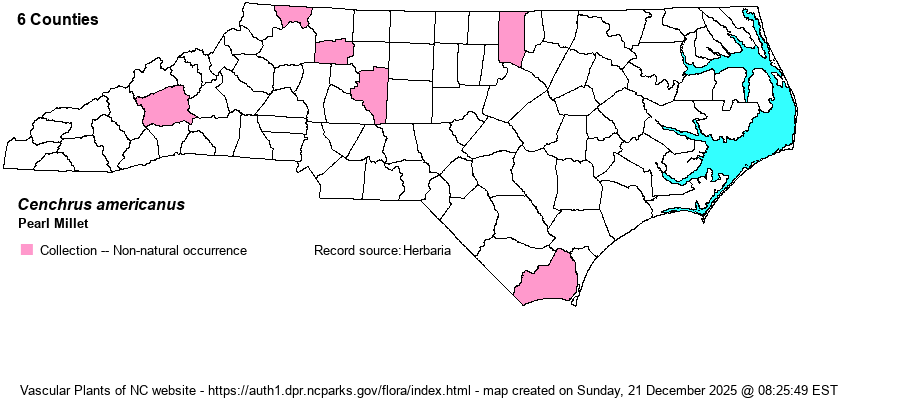| Author | (L.) Morrone | |
| Distribution | Scattered records from the Mountains and northern Piedmont; disjunct to Brunswick County. However, it could be found anywhere as a local escape from cultivation. Specimens from counties not colored on the map are from food plots, nurseries, gardens, arboretums.
Native to Asia; in N.A. scattered from VA to FL and TX; OK, MO, NE, CA. | |
| Abundance | Rare as locally established populations. Do these really represent reproducing and viable populations? Widely planted for wildlife in food plots across the state. | |
| Habitat | Dry to mesic roadsides, disturbed soil. | |
| Phenology | Flowering and fruiting August-October. | |
| Identification | Pearl Millet is a robust, branched grass, with culms reaching 3-6 feet tall (reportedly more) and terminal, very dense inflorescences. The latter produce many thousands of florets. Note that the bristles of the florets are short (a maximum of 6.3 mm), much shorter than our species of Setaria. The inner bristles are not hardened and thorn-like or spine-like, as in our other Cenchrus. | |
| Taxonomic Comments | A long-used synonym is Pennisetum glaucum. The name Setaria glauca has been misapplied to this species (its correct name now is S. pumila).
Sandspurs are notorious for their extremely strong and sharp spines which catch on clothing, fur, and skin alike. The spines actually are flattened and extremely hardened bristles borne at the base of each spikelet. There also is a second set of bristles just outside the spines and not hardened. Care must be taken with a dissecting scope to reach accurate identification. NOTE: Some sites use "sandspur" and some use "sandbur" for the group common name for Cenchrus. In the Carolinas, at least, "sandspur" is much the more often used -- as do Weakley (2018) and RAB (1968) -- and thus the website editors are using that group common name. | |
| Other Common Name(s) | | |
| State Rank | SE | |
| Global Rank | GNR | |
| State Status | | |
| US Status | | |
| USACE-agcp | FACU link |
| USACE-emp | FACU link |

